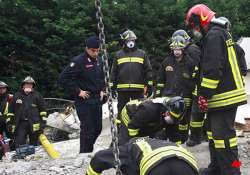Italy, May 21: Emergency crews inspected schools, churches and other buildings Monday for damage as aftershocks rattled northern Italy a day after a magnitude-6.0 earthquake killed seven people and toppled centuries-old buildings.
Agricultural experts were also tallying the damage to the prize of this area: its famed Parmesan cheese. Italian farm lobby group Coldiretti said some 400,000 huge, round cheeses were damaged after the racks where they are aged collapsed. The cheese loss was part of what Coldiretti estimated at ¤200 million ($254 million) in agricultural losses, which included slain livestock and damaged machinery.
Some 3,000 people spent the night in tent camps or their cars or school gyms, too afraid to sleep at home. They awoke Monday morning to a cold, steady rain.
Civil protection crews were checking government buildings, schools, businesses, homes, churches and other cultural heritage sites to evaluate the exact scale of damage and rebuilding costs, said Emilia Romagna regional president Vasco Errani.
“Unfortunately, the aftershocks are continuing and this is creating concern for the citizens,” Romana told Sky TG24. “This is something we have to deal with because there is a psychological aspect to this. As a result, we're speeding up the checks on the buildings.”
Premier Mario Monti, in Chicago for the NATO summit, was returning to Italy before the meeting ended. As of Monday morning there were no immediate plans for him to go to the quake zone, but he planned a Cabinet meeting Tuesday to declare a state of emergency for the area to free up federal funding.
The quake struck at 4:04 a.m. Sunday, with its epicenter about 35 kilometers (22 miles) north of Bologna at a relatively shallow depth of 5 kilometers (3.2 miles). Civil protection agency official Adriano Gumina described it as the worst to hit the region since the 1300s.
Four factory workers on an overnight shift were killed when their buildings, in three separate locations, collapsed. Another three people were said to have died, apparently from heart attacks or other health conditions brought on by fear. Dozens were injured.
One of the dead was a German woman, German Foreign Ministry spokesman Martin Schaefer said. He declined to give details, citing German privacy rules.
Emergency crews set up tent camps in soccer fields and converted school gyms into reception centers to house some of the estimated 3,000 people who were either too afraid or unable to return home.
Resident Donatella Gadda spent the night in her car, too afraid to sleep at home even though civil protection officials said it was safe.
“Honestly I don't feel up to it, because you know I'm really afraid. I live on the second floor,” she said as she returned home Monday morning to get more blankets. “You have to walk down the stairs to get out (when a quake hits). That's the situation, it's dramatic.”
Nearly 12 hours after the quake, a sharp aftershock alarmed the residents of Sant'Agostino di Ferrara and knocked off a segment of the city hall's wall. The building had already been pummeled by the pre-dawn quake, which left a gaping hole on one side.
The same aftershock knocked down most of the clock tower in the town of Finale Emilia, injuring a firefighter and leaving only half the clock attached. The national geophysics institute assigned an initial magnitude of 5.1 to the aftershock.
In 2009, a temblor killed more than 300 people in the central city of L'Aquila, where the historic center is still largely uninhabited and in ruins.
Latest World News
